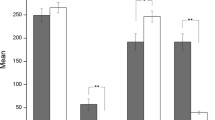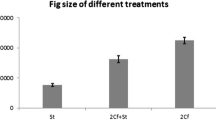Abstract
Differential occupancy of space can lead to species coexistence. The fig–fig wasp pollination system hosts species-specific pollinating and parasitic wasps that develop within galls in a nursery comprising a closed inflorescence, the syconium. This microcosm affords excellent opportunities for investigating spatial partitioning since it harbours a closed community in which all wasp species are dependent on securing safe sites inside the syconium for their developing offspring while differing in life history, egg deposition strategies and oviposition times relative to nursery development. We determined ontogenetic changes in oviposition sites available to the seven-member fig wasp community of Ficus racemosa comprising pollinators, gallers and parasitoids. We used species distribution models (SDMs) for the first time at a microcosm scale to predict patterns of spatial occurrence of nursery occupants. SDMs gave high true-positive and low false-positive site occupancy rates for most occupants indicating species specificity in oviposition sites. The nursery microcosm itself changed with syconium development and sequential egg-laying by different wasp species. The number of sites occupied by offspring of the different wasp species was negatively related to the risk of syconium abortion by the plant host following oviposition. Since unpollinated syconia are usually aborted, parasitic wasps ovipositing into nurseries at the same time as the pollinator targeted many sites, suggesting response to lower risk of syconium abortion owing to reduced risk of pollination failure compared to those species ovipositing before pollination. Wasp life history and oviposition time relative to nursery development contributed to the co-existence of nursery occupants.





Similar content being viewed by others
References
Al-Beidh S, Dunn DW, Power SA, Cook JM (2012) Parasites and mutualism function: measuring enemy-free space in a fig–pollinator symbiosis. Oikos 121:1833–1839. doi:10.1111/j.1600-0706.2011.20179.x
Albrecht M, Gotelli NJ (2001) Spatial and temporal niche partitioning in grassland ants. Oecologia 126:134–141. doi:10.1007/s004420000494
Anstett M-C (2001) Unbeatable strategy, constraint and coevolution, or how to resolve evolutionary conflicts: the case of the fig/wasp mutualism. Oikos 95:476–484. doi:10.1034/j.1600-0706.2001.950313.x
Anstett M-C, Bronstein JL, Hossaert-McKey M (1996) Resource allocation: a conflict in the fig/fig wasp mutualism? J Evol Biol 9:417–428. doi:10.1046/j.1420-9101.1996.9040417.x
Bailey R, Schönrogge K, Cook JM, Melika G, Csóka G, Thuróczy C, Stone GN (2009) Host niches and defensive extended phenotypes structure parasitoid wasp communities. PLoS Biol 7:e1000179. doi:10.1371/journal.pbio.1000179
Bland JM, Altman DG (2000) The odds ratio. Brit Med J 320:1468. doi:10.1136/bmj.320.7247.1468
Brodeur J, Boivin G (2004) Functional ecology of immature parasitoids. Annu Rev Entomol 49:27–49. doi:10.1146/annurev.ento.49.061703.153618
Bronstein JL (1988) Mutualism, antagonism, and the fig–pollinator interaction. Ecology 69:1298–1302. doi:10.2307/1941287
Bronstein JL (1991) The non pollinating wasp fauna of Ficus pertusa: exploitation of a mutualism? Oikos 61:175–186
Bronstein JL (1992) Seed predators as mutualists: ecology and evolution of the fig/pollinator interaction. In: Bernays E (ed) Insect–plant interactions. CRC Press, Boca Raton, pp 1–44
Compton SG, Nefdt RJC (1988) Extra-long ovipositors in chalcid wasps: some examples and observations. Antenna 12:102–105
Compton SG, Rasplus J-Y, Ware AB (1994) African fig wasp parasitoid communities. In: Hawkins B, Sheehan W (eds) Parasitoid community ecology. Oxford University Press, Oxford, pp 343–368
Cook JM, Rasplus J-Y (2003) Mutualists with attitude: coevolving fig wasps and figs. Trends Ecol Evol 18:241–248. doi:10.1016/S0169-5347(03)00062-4
Cruaud A, Jabbour-Zahab R, Genson G, Kjellberg F, Kobmoo N, van Noort S, Da-Rong Y, Yan-Qiong P, Ubaidillah R, Hanson PE, Santos-Mattos O, Farache FHA, Pereira RAS, Kerdelhué C, Rasplus J-Y (2011) Phylogeny and evolution of life-history strategies in the Sycophaginae non-pollinating fig wasps (Hymenoptera, Chalcidoidea). BMC Evol Biol 11:178. doi:10.1186/1471-2148-11-178
Després L, Jaeger N (1999) Evolution of oviposition strategies and speciation in the globeflower flies Chiastocheta spp. (Anthomyiidae). J Evol Biol 12:822–831. doi:10.1046/j.1420-9101.1999.00088.x
Dunn DW, Segar ST, Ridley J, Chan R, Crozier RH, Yu DW, Cook JM (2008) A role for parasites in stabilising the fig–pollinator mutualism. PLoS Biol 6:e59. doi:10.1371/journal.pbio.0060059
Eggleton P, Belshaw R (1993) Comparison of dipteran, hymenopteran and coleopteran parasitoids: provisional phylogenetic explanations. Biol J Linn Soc 48:213–226. doi:10.1111/j.1095-8312.1993.tb00888.x
Elias LG, Menezes AO Jr, Pereira RAS (2008) Colonization sequence of non-pollinating fig wasps associated with Ficus citrifolia in Brazil. Symbiosis 45:107–111
Elias LG, Teixeira SP, Kjellberg F, Pereira RAS (2012) Diversification in the use of resources by Idarnes species: bypassing functional constraints in the fig–fig wasp interaction. Biol J Linn Soc 106:114–122
Elith J, Leathwick JR (2009) Species distribution models: ecological explanation and prediction across space and time. Annu Rev Ecol Evol Syst 40:677–697. doi:10.1146/annurev.ecolsys.110308.120159
Fawcett T (2006) An introduction to ROC analysis. Pattern Recogn Lett 27:861–874. doi:10.1016/j.patrec.2005.10.010
Galil J (1977) Fig biology. Endeavour 1:52–56
Galil J, Eisikowitch D (1968) On the pollination ecology of Ficus sycomorus in East Africa. Ecology 49:259–269. doi:10.2307/1934454
Gallet C, Ibanez S, Zinger L, Taravel FR, Trierweiler M, Jeacomine I, Després L (2007) Plant chemical defense induced by a seed-eating pollinator mutualist. J Chem Ecol 33:2078–2089. doi:10.1007/s10886-007-9362-6
Ganeshaiah KN, Kathuria P, Uma Shaanker R, Vasudeva R (1995) Evolution of style-length variability in figs and optimization of ovipositor length in their pollinator wasps: a coevolutionary model. J Genet 74:25–39. doi:10.1007/BF02924244
Ganeshaiah KN, Kathuria P, Uma Shaanker R (1999) Does optimal packing of flowers in syconia shape style length variation in monoecious figs? Biotropica 31:312–320. doi:10.1111/j.1744-7429.1999.tb00143.x
Ghara M, Borges RM (2010) Comparative life-history traits in a fig wasp community: implications for community structure. Ecol Entomol 35:139–148. doi:10.1111/j.1365-2311.2010.01176.x
Ghara M, Kundanati L, Borges RM (2011) Nature’s Swiss army knives: ovipositor structure mirrors ecology in a multitrophic fig wasp community. PLoS ONE 6:e23642. doi:10.1371/journal.pone.0023642
Herberich E, Sikorski J, Hothorn T (2010) A robust procedure for comparing multiple means under heteroscedasticity in unbalanced designs. PLoS ONE 5:e9788. doi:10.1371/journal.pone.0009788
Herre EA, Jandér KC, Machado CA (2008) Evolutionary ecology of figs and their associates: recent progress and outstanding puzzles. Annu Rev Ecol Evol Syst 39:439–458. doi:10.1146/annurev.ecolsys.37.091305.110232
Holt RD, Lawton JL (1993) Apparent competition and enemy-free space in insect host-parasitoid communities. Am Nat 142:623–645. doi:10.1086/285561
Ibanez S, Gallet C, Dommanget F, Després L (2009) Plant chemical defence: a partner control mechanism stabilising plant–seed-eating pollinator mutualisms. BMC Evol Biol 9:261. doi:10.1186/1471-2148-9-261
Jandér KC, Herre EA, Simms EL (2012) Precision of host sanctions in the fig tree–fig wasp mutualism: consequences for uncooperative symbionts. Ecol Lett 15:1362–1369. doi:10.1111/j.1461-0248.2012.01857.x
Janzen DH (1979) How to be a fig. Annu Rev Ecol Syst 10:13–51. doi:10.1146/annurev.es.10.110179.000305
Jeffries MJ, Lawton JH (1984) Enemy free space and the structure of ecological communities. Biol J Linn Soc 23:269–286. doi:10.1111/j.1095-8312.1984.tb00145.x
Jones TS, Godfray HCJ, van Veen FJF (2009) Resource competition and shared natural enemies in experimental insect communities. Oecologia 159:627–635. doi:10.1007/s00442-008-1247-z
Jousselin E, Van Noort S, Berry V, Rasplus J-Y, Rønsted N, Erasmus JC, Greeff JM (2008) One fig to bind them all: host conservatism in a fig wasp community unraveled by cospeciation analyses among pollinating and nonpollinating fig wasps. Evolution 62:1777–1797. doi:10.1111/j.1558-5646.2008.00406.x
Kerdelhué C, Rasplus J-Y (1996) Non-pollinating Afrotropical fig wasps affect the fig–pollinator mutualism in Ficus within the subgenus Sycomorus. Oikos 75:3–14
Kerdelhué C, Rossi JP, Rasplus J-Y (2000) Comparative community ecology studies on Old World figs and fig wasps. Ecology 81:2832–2849. doi:10.1890/0012-9658(2000)081
Kronfeld-Schor N, Dayan T (2003) Partitioning of time as an ecological resource. Annu Rev Ecol Evol Syst 34:153–181. doi:10.1146/annurev.ecolsys.34.011802.132435
Lachaise D, Tsacas L, Couturier G (1982) The Drosophilidae associated with tropical African figs. Evolution 36:141–151. doi:10.2307/2407976
Nefdt RJC, Compton SG (1996) Regulation of seed and pollinator production in the fig–fig wasp mutualism. J Anim Ecol 65:170–182
Osawa T, Mitsuhashi H, Uematsu Y, Ushimaru A (2011) Bagging GLM: improved generalized linear model for the analysis of zero-inflated data. Ecol Inform 6:270–275. doi:10.1016/j.ecoinf.2011.05.003
Pellmyr O, Leebens-Mack J (2000) Reversal of mutualism as a mechanism for adaptive radiation in yucca moths. Am Nat 156:S62–S76. doi:10.1086/303416
Pompanon F, Pettex E, Després L (2006) Patterns of resource exploitation in four coexisting globeflower fly species (Chiastocheta sp.). Acta Oecol 29:233–240. doi:10.1016/j.actao.2005.11.003
Ranganathan Y (2012) Ants, figs, fig wasps: the chemical ecology of a multitrophic system. PhD dissertation, Indian Institute of Science
Ranganathan Y, Ghara M, Borges RM (2010) Temporal associations in fig-wasp-ant interactions: diel and phenological patterns. Entomol Exp Appl 137:50–61. doi:10.1111/j.1570-7458.2010.01038.x
Raxworthy CJ, Martinez-Meyer E, Horning N, Nussbaum RA, Schneider GE, Ortega-Huerta MA, Peterson AT (2003) Predicting distributions of known and unknown reptile species in Madagascar. Nature 426:837–841. doi:10.1038/nature02205
Schoener TW (1968) The Anolis lizards of Bimini: resource partitioning in a complex fauna. Ecology 49:704–726. doi:10.2307/1935534
Schoener TW (1974) Resource partitioning in ecological communities. Science 185:27–39. doi:10.1126/science.185.4145.27
van Veen FJF, Morris RJ, Godfray HCJ (2006) Apparent competition, quantitative food webs, and the structure of phytophagous insect communities. Annu Rev Entomol 51:187–208. doi:10.1146/annurev.ento.51.110104.151120
Wang H, Ridley J, Dunn DW, Wang R, Cook JM, Yu DW (2012) Biased oviposition and biased survival together help resolve a fig–wasp conflict. Oikos. doi:10.1111/j.1600-0706.2012.20463.x
West SA, Herre EA (1994) The ecology of the New World fig-parasitizing wasps Idarnes and implications for the evolution of the fig-pollinator mutualism. Proc R Soc Lond B 258:67–72. doi:10.1098/rspb 1994.0143
Acknowledgments
We thank the Ministry of Environment and Forests, Government of India, for supporting this research. We also thank Gautam Pramanik, Kanchan Jogdev, Santhosh Revadi, and Yathiraj Ganesh for help with collecting the samples. For assistance with data analysis we thank Meera Mane and Meghana Kulkarni. We are grateful to Takeshi Osawa for help with the bagging GLM analysis and for sending us the relevant R code, and to three anonymous reviewers and Alexander Bradley Duthie for insightful comments on the manuscript. We are especially thankful to Lakshy Katariya, Karpagam Chelliah, Venkatappa and Mary Sunitha for technical support.
Author information
Authors and Affiliations
Corresponding author
Additional information
Communicated by Handling Editor: Lars Chittka.
Electronic supplementary material
Below is the link to the electronic supplementary material.
11829_2014_9300_MOESM2_ESM.jpg
Syconial cross section and egg deposition by Apocryptophagus stratheni in pre-A phase. (a–b) The eggs deposited inside the syconium lumen. The flowers are still undifferentiated into sessile and pedicellate forms. (c) Large galls projecting into syconium lumen. These galls contain developing Apocryptophagus stratheni (JPEG 381 kb)
Rights and permissions
About this article
Cite this article
Ghara, M., Ranganathan, Y., Krishnan, A. et al. Divvying up an incubator: How parasitic and mutualistic fig wasps use space within their nursery microcosm. Arthropod-Plant Interactions 8, 191–203 (2014). https://doi.org/10.1007/s11829-014-9300-9
Received:
Accepted:
Published:
Issue Date:
DOI: https://doi.org/10.1007/s11829-014-9300-9




